This article has been reviewed according to Science X's editorial process and policies. Editors have highlighted the following attributes while ensuring the content's credibility:
fact-checked
peer-reviewed publication
trusted source
proofread
Researcher finds mothers live longer as child mortality declines

The dramatic decline in childhood mortality during the 20th century has added a full year to women's lives, according to a new study.
"The picture I was building in my mind was to think about what the population of mothers in the U.S. looked like in 1900," said Matthew Zipple, a Klarman Postdoctoral Fellow in neurobiology and behavior in the College of Arts and Sciences and author of "Reducing Childhood Mortality Extends Mothers' Lives," which published May 9 in Scientific Reports.
"It was a population made up of two approximately equal-sized groups: One was mothers who had lost children, and one was mothers who had not," Zipple said. "If we compare that to today, when child loss is mercifully so much less common, nearly all those women who had lost children are shifted into the non-bereaved category."
Several studies find that mothers are more likely to die in the years following the death of a child, Zipple said. This effect does not show up in fathers.
Using mathematical modeling based on Centers for Disease Control and Prevention (CDC) data, he calculated how the absence of bereavement affects the lifespans of present-day mothers in the United States. He estimates that the reduction in maternal bereavement adds, on average, a year to women's lives.
As a doctoral student researching fitness links between mothers and offspring, Zipple found a pattern of maternal death following offspring death in nonhuman primates. In the animals, the effect was attributed to the mothers being in poor condition and less able to care for their offspring.
But in humans, the same sequence of events—offspring death followed by maternal death—has been interpreted differently in literature from studies with a human focus. Instead, epidemiologists and public health researchers conclude that the physical and psychological costs of the trauma of losing a child makes mothers more likely to die.
In the paper, Zipple cites several studies that causally link child death with increased risk of maternal death. The most comprehensive is a study of mothers in Iceland over a 200-year period, spanning a range of health care access and industrialization. It controls for genetics by comparing siblings and shows that bereaved fathers are no more likely than non-bereaved fathers to die in the years following a child's death.
Another study in Sweden shows that mothers are at higher risk of death on and around the anniversary of their child's death than at other times. Common causes of death in bereaved mothers, according to various studies, include heart attack and suicide.
"There's a huge peak of mortality risk immediately in the week surrounding the anniversary," Zipple said. "It's hard to come to a different conclusion than that is the cause, remembering this experience."
Life expectancy for women after age 15 increased by about 16 years between 1900 and 2000, Zipple found from the CDC data he used in the study. His calculation attributes one year, or about 6% of this increase, to the dramatic drop in childhood mortality over the course of the 20th century.
"One of the most awful things one can imagine is losing a child. And we've been able to reduce the frequency of that in our society by more than 95%. That's amazing. That's something to celebrate," Zipple said.
"It's easy to lose sight of progress that happens over the course of a century because it's well beyond any individual's lifetime. But this extension in overall lifespan over the last 100 years has set up human populations and experience to be so much better than they ever have been before."
The study also helps set priorities for improving the future, Zipple said. In many countries, child mortality rates today are similar to those in the U.S. in 1900. Investing in reducing childhood mortality everywhere helps not only the children, but whole communities.
"The child is the core of the community," Zipple said. "Protecting children from mortality has branching positive impacts that start with mothers but probably don't stop there."
More information: Matthew N. Zipple, Reducing childhood mortality extends mothers' lives, Scientific Reports (2024). DOI: 10.1038/s41598-024-61217-w




















